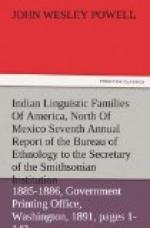Only a small portion of the territory occupied by this family is included within the United States, the greater portion being in Mexico where it extends to the Gulf of California. The family is represented in the United States by three tribes, Pima alta, Sobaipuri, and Papago. The former have lived for at least two centuries with the Maricopa on the Gila River about 160 miles from the mouth. The Sobaipuri occupied the Santa Cruz and San Pedro Rivers, tributaries of the Gila, but are no longer known. The Papago territory is much more extensive and extends to the south across the border. In recent times the two tribes have been separated, but the Pima territory as shown upon the map was formerly continuous to the Gila River.
According to Buschmann, Gatschet, Brinton, and others the Pima language is a northern branch of the Nahuatl, but this relationship has yet to be demonstrated.[75]
[Footnote 75: Buschmann,
Die Pima-Sprache und die Sprache der
Koloschen, pp. 321-432.]
PRINCIPAL TRIBES.
Northern group:
Opata.
Papago.
Pima.
Southern group:
Cahita.
Cora.
Tarahumara.
Tepeguana.
Population.—Of the above tribes the Pima and Papago only are within our boundaries. Their numbers under the Pima Agency, Arizona,[76] are Pima, 4,464; Papago, 5,163.
[Footnote 76: According to the U.S. Census Bulletin for 1890.]
PUJUNAN FAMILY.
> Pujuni, Latham in Trans. Philolog.
Soc. Lond., 80, 1856 (contains
Pujuni, Secumne, Tsamak of Hale, Cushna
of Schoolcraft). Latham,
Opuscula, 346, 1860.
> Meidoos, Powers in Overland Monthly, 420, May, 1874.
= Meidoo, Gatschet in Mag. Am.
Hist., 159, 1877 (gives habitat and
tribes). Gatschet in Beach, Ind.
Misc., 433, 1877.
> Mai’-du, Powers in Cont. N.A. Eth., III, 282, 1877 (same as Mai’-deh; general account of; names the tribes). Powell, ibid., 586 (vocabs. of Kon’-kau, Hol-o’-lu-pai, Na’-kum, Ni’-shi-nam, “Digger,” Cushna, Nishinam, Yuba or Nevada, Punjuni, Sekumne, Tsamak).
> Neeshenams, Powers in Overland Monthly,
21, Jan., 1874 (considers
this tribe doubtfully distinct from Meidoo
family).
> Ni-shi-nam, Powers in Cont. N.A.
Eth., III, 313, 1877
(distinguishes them from Maidu family).
X Sacramento Valley, Keane, App.
Stanford’s Comp. (Cent. and So. Am.),
476, 1878 (Ochecumne, Chupumne, Secumne,
Cosumne, Sololumne, Puzlumne,
Yasumne, etc.; “altogether
about 26 tribes").
The following tribes were placed in this group by Latham: Pujuni, Secumne, Tsamak of Hale, and the Cushna of Schoolcraft. The name adopted for the family is the name of a tribe given by Hale.[77] This was one of the two races into which, upon the information of Captain Sutter as derived by Mr. Dana, all the Sacramento tribes were believed to be divided. “These races resembled one another in every respect but language.”




